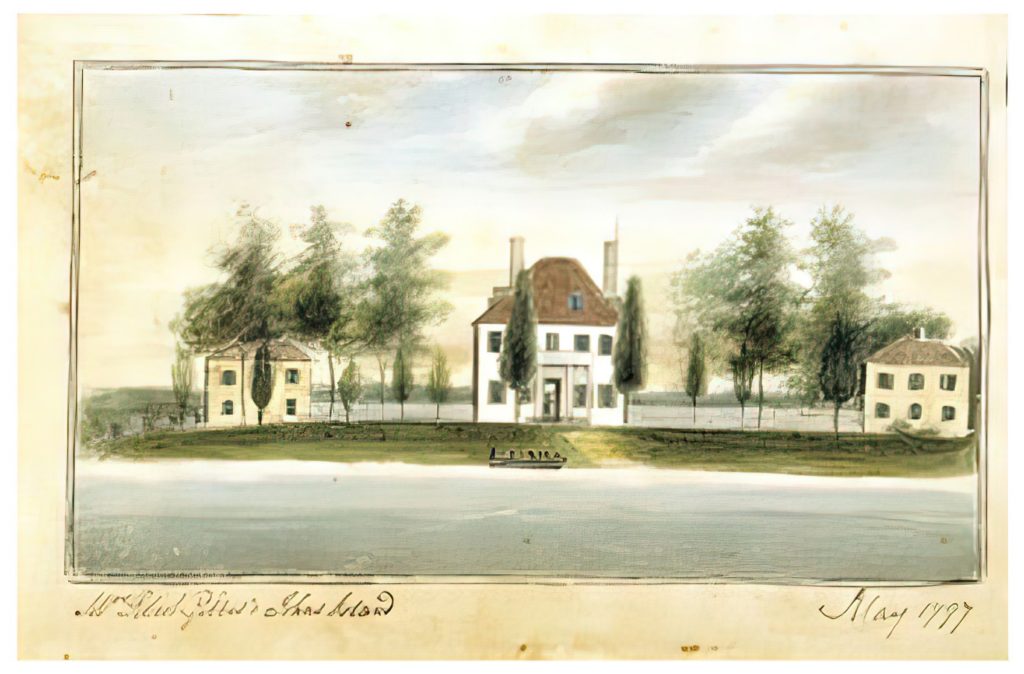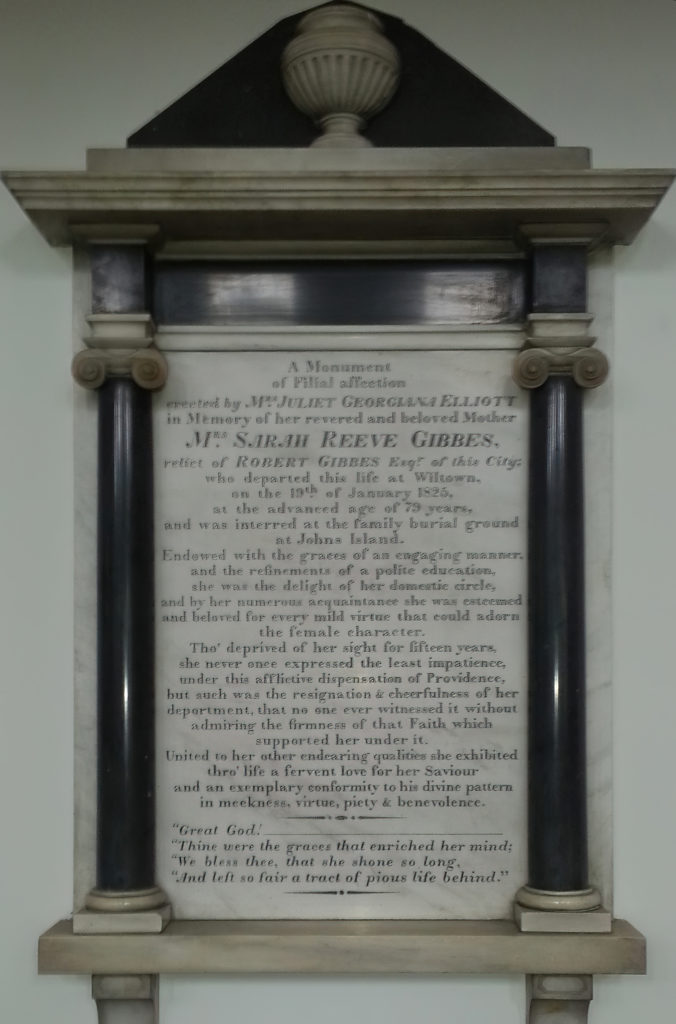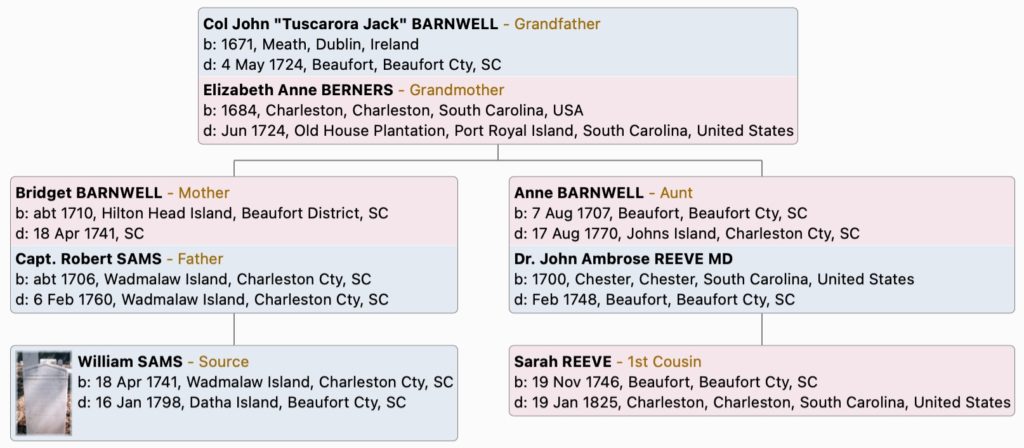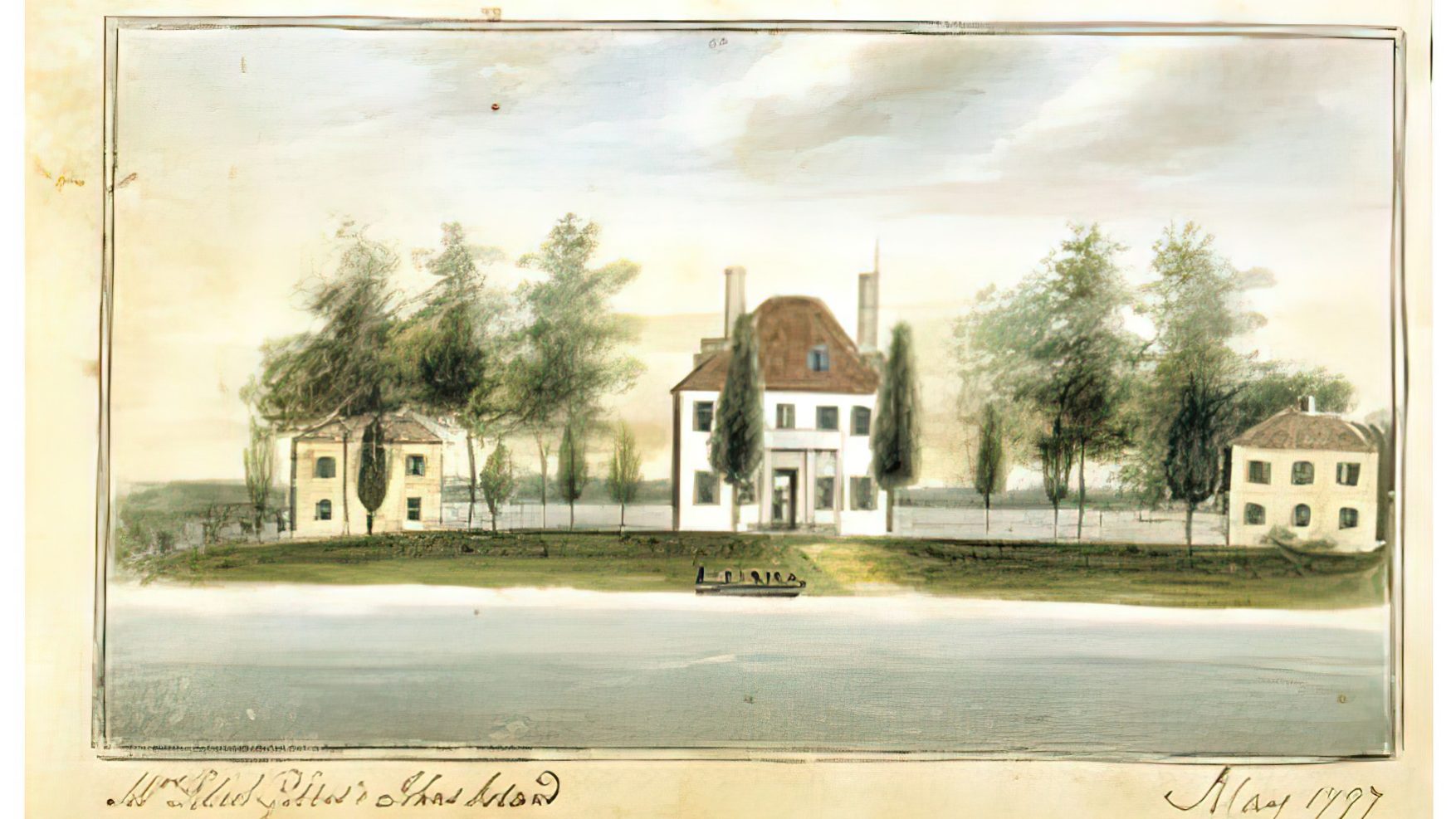Peaceful Retreat plantation home of Robert Gibbes and his wife Sarah (Reeve) Gibbes. On the Stono River, John’s Island, SC.
There is so much to say about this woman. She has been in the shadows of our history for quite a while. Sarah and her husband, Robert Gibbes (1732-1794), sold Datha Island to William Sams and his wife Elizabeth in 1783. Recently her name came up again when we did the drone overflight of the Lewis Reeve Sams plantation house ruins up on the Morgan River. That inspired our resident and long-time Dataw Historic Foundation member Jane Griffith to dig deeper into the historical records of Sarah Reeve Gibbes and others in her 18th-century circles. This led us to elements of Sarah’s life story that are amazing; her poetry and her relationship to William Sams.
But first, let me set the stage by delving into her ancestry. The Gibbes, Sams, and Barnwell familial connections trace to William Sams (1741-1798) from two critical women in his life. Both women are daughters of his maternal grandfather, Col John “Tuscarora Jack” Barnwell (1671-1724). William’s mother was Bridget (Barnwell) Sams (abt 1710-1741), who married into the Sams family via Capt Robert Sams (1706-1760). Bridget’s sister, Anne (Barnwell) Gibbes (1707-1770), married Col John Gibbes (1696-1764).
Gibbes
Both John Gibbes and Anne Barnwell had been previously married. John had one son, Robert Gibbes (1732-1794), by his first marriage and none with his second wife, Anne. Robert will come up again in a minute. Note this marriage made Anne (Barnwell) Gibbes the stepmother of Robert Gibbes. Anne’s ancestry is also complicated because she married four times. John Gibbes was Anne’s fourth husband.
The only husband Anne had children with was Dr. J. Ambrose Reeve (1700-1748), her second husband. Two children lived into adulthood; Lewis Reeve (1739-1774) and Sarah Reeve (1746-1825).
So far, Anne seems to provide a pretty thin connection between the Barnwell and Gibbes families. After all, none of her children, save her stepson Robert Gibbes, had any Gibbes bloodline. That was about to change.
In 1764 Anne and Dr. Reeve’s daughter Sarah married her mother’s stepson Robert Gibbes (1732-1794)!
Sarah was 18, and Robert was 32. They would have many children together during a 30-year marriage; reports vary from eight to ten. These children have a direct bloodline up the Barnwell chain, via Anne, to Col John “Tuscarora Jack” Barnwell and back to England. And they had a Gibbes bloodline back to Robert’s grandfather, Robert Gibbes (1644-1715). Grandfather Robert served as a Proprietors Deputy, Governor of Carolina Province, and Chief Justice of Carolina Province. In addition, Sarah (Reeve) Gibbe’s husband, Robert, had a great grandfather, Dr. Henry Woodward, MD (1646-1686), who was the first white settler from England in the Province of Carolina. Solid colonial roots.
Sams
Bridget Barnwell (abt 1710-1741), Anne’s sister, married into the Sams family in 1727 when she was about 17, and Capt Robert Sams (1706-1760) was 21. Unfortunately, she had a tragically short life. She died in the third decade of her life, giving birth to ‘our’ William Sams (1741-1798).
I believe that William became very close to his Aunt Anne (Barnwell) Reeve. First, she was near in age to the mother he never knew and his aunt. Second, she had two children, his cousins, who were about his age. The Reeves were centered in Beaufort so the Reeve cousins grew up in Beaufort. However, Sarah (Reeve) Gibbes moved in 1764 with her new husband Robert to “Peaceful Retreat,” the Gibbes plantation at Stono Landing on John’s Island, near Charles Town (now Charleston), South Carolina. Their first child came along in 1765, which brings me to my third point about the cousin’s close relationship. William had been married in 1761. He and Elizabeth had their first of seven sons in 1764. William Sams and his cousin Sarah R. Gibbes were starting families in the same area of SC, just south of Charleston, at the same time. William Sams was born, raised, and lived on Wadmalaw Island, just ten miles from cousin Sarah and her family. The William Sams and Robert Gibbes families were colonial neighbors for twenty years. Lastly, William Sams and his wife Elizabeth honored the Reeve family when they named a son after William’s cousin, Lewis Reeve. For these reasons, I believe that William and Sarah were not only cousins but close friends.

American Revolution
Before I get to William’s purchase of Datha Island, there is an important development; the American Revolution. Robert Gibbes had gout (a common form of inflammatory arthritis that is very painful.) By most accounts, he was wheelchair-bound. Some reports even mention he had little use of his hands. In any case, he could not participate in the conflict and was dependent on his wife, Sarah during this trying time.
Here’s one report of their situation by Stephen B. Barnwell.
“The Gibbes plantation, Peaceful Retreat, on John’s Island was well known throughout the country as the seat of hospitality and elegant taste. Robert was prevented by gout from active participation in the Revolution. Still, he supported it, and his house was open for the reception and entertainment of the friends of liberty. Even as a young woman, Sarah gave evidence that she possessed a mind of no common order.
Because of her husband’s illness, the care and management of their estates and all the household duties fell upon her. In addition to her own nine children, she raised seven orphan nephews and nieces and, for a while, her nephew/cousin Robert W. Barnwell, who had been wounded in battle. The multiplied cares involved in meeting all these responsibilities, with the superintendence of household concerns, required a rare degree of energy and activity; yet the mistress of this well-ordered establishment always had a ready and cordial welcome for her friends.” [Barnwell]
Its also reported during the war that their plantation home was evacuated during a battle; some even say it was burnt to the ground by the British and rebuilt later. For instance, in Descendents of Robert Gibbes, Alice Hawkins Quinn states, “The old Gibbes house was burned, but a mound of broken bricks marked the site.” It’s believed the house she refers to is the one that the British bombarded during the invasion of Prevost in 1779, which Quinn discusses further:
“This beautiful house and grounds attracted the attention of the British during the invasion of Prevost and there is a long story of how her servants advised her the British were coming and she ordered the children dressed, assisted her husband, who was afflicted with gout, to get into his rolling chair and awaited the coming of the British. The officers took immediate possession of the house, leaving the premises to their men and extending no protection against pillage. The soldiers roved at their pleasure about the plantation, helping themselves to whatever they chose; breaking into the wine, drinking to intoxication, and seizing and carrying off the Negroes. When the plantation was bombarded, Mrs. Gibbes and the children set off to an adjoining plantation.” [Quinn]
This may be family lore; I have not been able to corroborate it. However, it appears Robert and Sarah Gibbes were indeed friends of liberty.
Poetry
We don’t know, and may never know, how Sarah’s 18th-century diary ended up at the Tuff Library at Colorado College in Colorado Springs, CO. However, in 2002, Elizabeth Culbertson of the U.S. Air Force Academy did a partial transcription. Miss Culbertson posits from Sarah’s information in the diary that she was inspired to start writing in late 1775 at the death, in childbirth, of her stepdaughter Mary ‘Polly’ (Gibbes) Middleton. Polly was only 17. The most striking example of her writing in the diary is her poetry.
Here’s the first example.
Epitaph design’d for My ever Dear and Beloved, Daughter -Mary Middleton- who
Sarah Reeve Gibbes, August 10, 1776
quitted this transitory Life. Nov 29, 1775, Wednesday
Aged 17 years 8 months 8 days and a half
Leaving an infant daughter Six hours old
Another early example.
We candid few, who tread this sacred ground
Sarah Reeve Gibbes
To pensive meditation’s awful round.
Regard this spot, nor check the starting tear
A Child, whose merits claim it well, lies here,
Farewell, bright pattern of unblemish’d youth
Of mildest merit, modesty, and truth!
Death snatch’d thy sweetness in the genial hour,
Just when the stem put forth its infant flower
Still blooms the flower: as oft we see
Fair branches budding from the lifeless tree
This last example comes from a series of four poems written in late 1782, near the end of our American Revolution.
The Complaint
Peace and content are from my bosom fled,
Those dear companions of my younger days
Through pleasing paths where sportive fancy led,
Their influence beam’d with constant mildest rays.-
Calm and serene were my hours of rest
Sweet were my slumbers, and my thoughts compos’d:
No grief corroding did invade my breast
Nor anxious cares my happiness oppos’d.
Each welcome day in chearful mirth was spent-
No baneful passion harbour’d in my mind
I grateful own’d the gift that fortune lent
Nor envy’d those for higher ranks design’d…
Ah! happy days! alone by mem’ry known,
Which brings to view the joys I once possessed;
Joys, which forever far from me are flown
For Mary’s Death! Has rob’d my soul of rest.
Ye s it is past! The dear delusion’s o’er!
Lost to the world in some recluse abode,
I’ll secret mourn the cause of my woe.Gracious God. grant me 0! grant me Consolation; and resignation to thy divine will
Sarah Reeve Gibbes, 1782
Sarah died 19 January 1825 at the age of 78 in Charleston. She is buried in the Gibbes Family Cemetery on John’s Island. This memorial in a Charleston Church was dedicated by her daughter.

Datha Island
Sarah’s brother, Lewis Reeve, inherited Datha Island from his mother, Anne (Barnwell) Wigg (fourth husband), in 1770. Some report that he cultivated indigo on Datha. This is undoubtedly feasible since his uncle Nathaniel Barnwell was known as the most prominent indigo planter in Beaufort District [Rowland.] Indigo was a profitable crop from about 1745 up until the start of the revolution. However, none of the many archaeological digs on Datha over the years have confirmed this postulate. In any case, Lewis Reeve owned Datha Island and willed it to his sister Sarah when he died in 1774. She sold it to William in 1783.
Her experience in the American Revolution tells me she and her husband were staunch patriots and certainly did NOT consider her cousin William Sams a Tory/British sympathizer. She would not have sold him Datha Island if she felt otherwise.
So while it may be that some felt William Sams sympathized with the British cause a bit too much, those who knew him best certainly did not feel that way. They viewed him as a patriot, just like them. And that is a big deal.
Bill Riski, June 2022

Sources
Barnwell, Stephen B., The Story of an American Family, 1969. Available in the Beaufort District Collection of the Beaufort County Library.
Find-A-Grave entry for Sarah Reeve Gibbes.
Gibbes, Sarah Reeve, Diary, 1775, Tuff Library, Colorado College, Colorado Springs, CO. Partially transcribed by Elizabeth Culbertson, 2002.
Quinn, Alice Hawkins, Descendants of Robert Gibbes (1644-1715); Colonial Governor of South Carolina, 1987
Rowland, Lawrence S., Moore, Alexander, Rogers Jr., George C. – The History of Beaufort County, South Carolina, Volume I, 1514 – 1861, 1996


